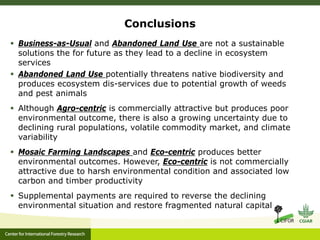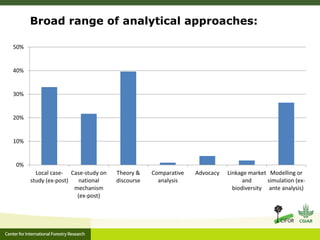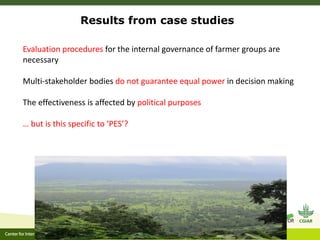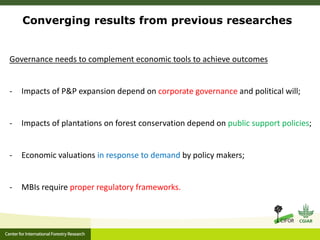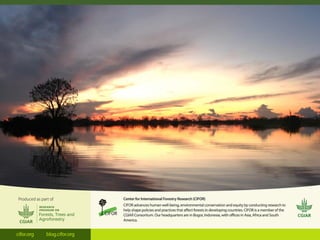Ecosystem Services in plantations: from economic valuations to market-based instruments
- 1. Ecosystem Services in plantations: from economic valuations to market-based instruments New Generation Plantations Annual Summit, Cape Town 18-19 June Himlal Baral & Romain Pirard
- 2. Economic evaluation of ecosystem goods and services under different landscape management scenarios
- 3. Study landscape background Australian landscapes are changing due to changing demands of society and climate change and variability Land use has gone through many cycles of land clearance, investment, abandonment Since European settlement of Victoria in the1830s, ~66% of native vegetation has been cleared Key NRM issues – declining water quality and quantity, salinity (irrigation and dryland), deterioration of soils, declining biodiversity, degradation of rivers and wetlands, increasing weeds and pest infestations
- 4. Background – policy context Bold, strategic and landscape-scale initiatives are required to reverse the land degradation The Australian Government and regional NRM agencies have adopted a wide range of sustainability approaches Range of market-based instruments for NRM are being operated in Australia – e.g., bush tender, eco-tender Carbon farming initiative – as a new economic opportunities for farmers and land managers
- 5. Study aims Identify and define the plausible future land use scenarios Identify and assess the key ecosystem services such as, carbon sequestration, agriculture production, water, biodiversity and timber in heavily modified and fragmented landscape Assess the projected changes in ecosystem goods and services under plausible future land use scenarios Analyse trade-offs and synergies
- 6. Study area and major land use categories • Largely degraded from clearing of native vegetation for agriculture as well as over allocation of irrigation water • Rainfall ~350 mm, 70 m asl • Size: 30,000 ha • High conservation value
- 7. Timber Methods: key research steps Step I • Collate spatial and attribute data • Land use and land cover classification • Identify and define ES for assessment Step II • 3 cost based scenarios, and assumptions • Estimation of ES flow • Value per ha Step III • Develop and define 5 future land use scenarios • Identify proposed land use change under each scenarios • Ecosystem services under each scenario Step IV • Spatial assessment – tradeoffs, synergies and interactions • Policy implications Carbon Water Biodiversity
- 8. Plausible future land use scenarios Business-as-usual • current farming and management systems continue with no significant changes in land use and land cover in the future Mosaic farming landscapes • reconfiguration of irrigated farming landscapes to more sustainable use, such as improved farming, low rainfall forestry and biodiversity plantings Eco-centric or environmental plantings • growing environmental concern and growth of new environmental commodities such as carbon and biodiversity credits, there will be substantial increase in environmental plantings Agro-centric or production oriented • higher demand of food/livestock production due to continued population growth in Australia and globally Abandoned land use • land abandonment due to the depopulation in rural areas, and significant uncertainly due to changing climate
- 9. Timber Methods: tools and resources Water Bush tender payments
- 10. Calculation - example NPV is the net present value ($/ha) P is the price of carbon, Qt is the quantity of CO2e sequestrated in year t, EC is the establishment cost, MC is the annual management cost, and r is the rate of discount
- 11. Returns from Carbon under various scenarios -$50 $0 $50 $100 $150 $200 $250 1% 3% 5% 7% 10% NPV $/ha Discountrate Conservative Optimistic Central
- 12. Returns from carbon +environmental payments -$50 $0 $50 $100 $150 $200 $250 1% 3% 5% 7% 10% NPV $/ha Discountrate Conservative Optimistic Central
- 13. Returns from Timber Plantations -$6,000 -$4,000 -$2,000 $0 $2,000 $4,000 $6,000 $8,000 $10,000 $12,000 1% 3% 5% 7% 10% NPV $/ha Discountrate Conservative Optimistic Central
- 14. EGS trend under various scenarios Land use scenarios Ecosystem Services Carbon Agri prodn Water Biodiversity Timber Business-as-usual = = Future farming landscapes = Eco-centric = Agro-centric = Land abandonment ? = For $ value see Baral et al. 2014, Land Use Policy
- 15. Conclusions Against any realistic investment criteria returns from carbon alone may not be commercially attractive in the study region Additional payments via the Victorian Government’s market based instruments such as, bush tender makes some scenarios attractive but they are nowhere close to current expected return from agriculture Planting for timber is not commercially attractive as it delivers only negative or very low returns under all except the most optimistic scenario (low cost with low discount rate)
- 16. Conclusions Business-as-Usual and Abandoned Land Use are not a sustainable solutions the for future as they lead to a decline in ecosystem services Abandoned Land Use potentially threatens native biodiversity and produces ecosystem dis-services due to potential growth of weeds and pest animals Although Agro-centric is commercially attractive but produces poor environmental outcome, there is also a growing uncertainty due to declining rural populations, volatile commodity market, and climate variability Mosaic Farming Landscapes and Eco-centric produces better environmental outcomes. However, Eco-centric is not commercially attractive due to harsh environmental condition and associated low carbon and timber productivity Supplemental payments are required to reverse the declining environmental situation and restore fragmented natural capital
- 17. Acknowledgements Contributors • Dr. S Kasel, Melbourne School of Land and Environment • Prof. RJ Keenan, Melbourne School of Land and Environment • Prof. NE Stork, Griffith University • Dr. SK Sharma, Carbon Planet Data and support • Kilter Pty Ltd • Bureau of Rural Sciences • North Central Catchment Management Authority • Victorian Department of Sustainability and Environment • Dr. R Benyon, CSIRO/ Uni of Melb Financial support • University of Melbourne • CRC For Forestry Himlal Baral © University of Melbourne 2012
- 18. Another economic approach to plantations: Market-based instruments for ES
- 19. THE ‘DISCOVERY’ OF A NEW GALAXY
- 20. With assumed strengths… Economic signals more effective and flexible Better resource allocation and efficiency Filling the funding gap for ES provision
- 21. … but also lots of confusion Inconsistent use of terms Mis-information of policy-makers An impediment to policy evaluation
- 22. 1. Direct markets (e.g. NTFPs for conservation) 2. Tradable permits (e.g. transferable development rights, carbon markets) 3. Regulatory price changes (e.g. eco-taxes or subsidies) 4. Voluntary price signals (e.g. FSC certification) 5. Coasean-type agreements (some PES, conservation concessions) A rough guide to the literature jungle
- 23. Broad range of analytical approaches: 0% 10% 20% 30% 40% 50% Local case- study (ex-post) Case-study on national mechanism (ex-post) Theory & discourse Comparative analysis Advocacy Linkage market and biodiversity Modelling or simulation (ex- ante analysis)
- 24. Broad range of evaluation criteria: 0% 10% 20% 30% 40% 50% 60% Efficiency Environmental effectiveness Equity Feasibility Food security Freedom of choice Legitimacy Participation Pro-poor Welfare Governance Development
- 25. Payments for Ecosystem Services 2.3% 7% 4.7% 34.9% 20.9% 0% 30.2% 0% 10% 20% 30% 40%
- 26. Do PES improve governance of reforestation? Two Indonesian cases
- 27. General implications of relying on PES Establishment of multi-stakeholder agencies as intermediary bodies between funder and planters to manage funds / distribute incentives Specific contracts assign objectives to planters with conditional payments
- 28. Results from case studies Evaluation procedures for the internal governance of farmer groups are necessary Multi-stakeholder bodies do not guarantee equal power in decision making The effectiveness is affected by political purposes … but is this specific to ‘PES’?
- 29. Converging results from previous researches Governance needs to complement economic tools to achieve outcomes - Impacts of P&P expansion depend on corporate governance and political will; - Impacts of plantations on forest conservation depend on public support policies; - Economic valuations in response to demand by policy makers; - MBIs require proper regulatory frameworks.
- 30. CIFOR Planted forests initiative - Stakeholders’ perceptions and expectations; - Labor issues; - Conflict mediation; - Community forestry / company-community partnerships; - Mapping of planted forests.
- 31. Further reading Pirard R., de Buren, and R. Lapeyre, 2014, Do PES improve governance of forest restoration?, Forests, 5 (3), pp. 404-24. Pirard, R., 2012, Payments for Environmental Services (PES) in the public policy landscape: “Mandatory” spices in the Indonesian recipe, Forest Policy and Economics, 18, pp. 23-29. Pirard, R., 2012, Market-based instruments for biodiversity and ecosystem services: A lexicon, Environmental Science & Policy, 19-20, pp. 59-68.















